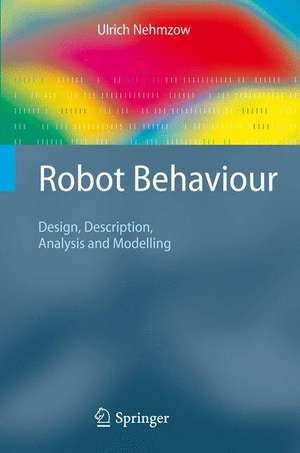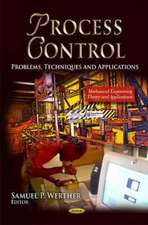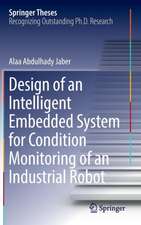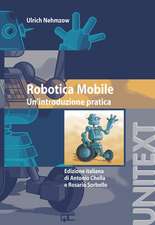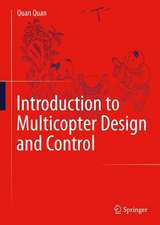Robot Behaviour: Design, Description, Analysis and Modelling
Autor Ulrich Nehmzowen Limba Engleză Paperback – 28 noi 2008
Preț: 331.25 lei
Preț vechi: 414.07 lei
-20% Nou
Puncte Express: 497
Preț estimativ în valută:
63.40€ • 68.89$ • 53.29£
63.40€ • 68.89$ • 53.29£
Carte tipărită la comandă
Livrare economică 21 aprilie-05 mai
Preluare comenzi: 021 569.72.76
Specificații
ISBN-13: 9781848003965
ISBN-10: 184800396X
Pagini: 272
Ilustrații: XVII, 252 p. 125 illus.
Dimensiuni: 155 x 235 x 14 mm
Greutate: 0.39 kg
Ediția:2009
Editura: SPRINGER LONDON
Colecția Springer
Locul publicării:London, United Kingdom
ISBN-10: 184800396X
Pagini: 272
Ilustrații: XVII, 252 p. 125 illus.
Dimensiuni: 155 x 235 x 14 mm
Greutate: 0.39 kg
Ediția:2009
Editura: SPRINGER LONDON
Colecția Springer
Locul publicării:London, United Kingdom
Public țintă
ResearchCuprins
to this Book.- A Brief Introduction to Mobile Robotic.- to Scientific Methods in Mobile Robotics.- Statistical Tools for Describing Experimental Data.- Describing Behaviour Quantitatively Through Dynamical Systems Theory and Chaos Theory.- Analysis of Agent Behaviour: Case Studies.- Computer Modelling of Robot-Environment Interaction.- Accurate Simulation Through System Identification.- Robot Programming Through System Identification.- Other Applications of Transparent Modelling Through System Identification.- Quantitative Comparison of Behaviours and Model Validity.- Conclusion.
Textul de pe ultima copertă
"Robot Behaviour - Design, Description, Analysis and Modelling" is the successor to the first textbook published in this field: Scientific Methods in Mobile Robotics and introduces the emerging field of scientific methods in mobile robotics to a wider audience of advanced undergraduate students, postgraduate students as well as researchers in robotics, artificial intelligence, cognitive science, ethology, biology and psychology.
Raising some of the big questions that roboticists should be concerned about - how can (robot) behaviour be described quantitatively?, how can experimental results be compared meaningfully?, is it possible to design faithful and accurate robot simulators@, etc - , this book gives indicators on how these might be addressed, and looks at how behaviour - in this case the behaviour of autonomous mobile robots – can be measured quantitatively, analysed, compared, and modelled. Statistical methods are introduced to compare behaviours and to state statistically significant differences in behaviour. Transparent modelling techniques derived from system identification are presented to obtain models of robot behaviour in closed mathematical form.
With numerous exercises (and solutions) and examples from research, including how robot behaviours can be compared and evaluated, how robot platform-independent code (Robot Java) can be obtained, how to determine analytically which sensors of a robot are important and which are not, and how to obtain robot control code directly from observing a human demonstrator,without any traditional programming, this book will be of great value to researchers and graduate students in mobile robotics, behavioural science and cognitive science.
Raising some of the big questions that roboticists should be concerned about - how can (robot) behaviour be described quantitatively?, how can experimental results be compared meaningfully?, is it possible to design faithful and accurate robot simulators@, etc - , this book gives indicators on how these might be addressed, and looks at how behaviour - in this case the behaviour of autonomous mobile robots – can be measured quantitatively, analysed, compared, and modelled. Statistical methods are introduced to compare behaviours and to state statistically significant differences in behaviour. Transparent modelling techniques derived from system identification are presented to obtain models of robot behaviour in closed mathematical form.
With numerous exercises (and solutions) and examples from research, including how robot behaviours can be compared and evaluated, how robot platform-independent code (Robot Java) can be obtained, how to determine analytically which sensors of a robot are important and which are not, and how to obtain robot control code directly from observing a human demonstrator,without any traditional programming, this book will be of great value to researchers and graduate students in mobile robotics, behavioural science and cognitive science.
Caracteristici
Practical examples of modelling and analysing observed behaviour, taken from real-world robotics scenarios Numerous listings of Scilab programs for modelling and statistical analysis of behavioural data Numerous exercises with solutions
